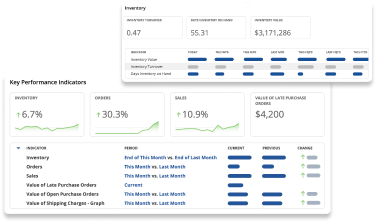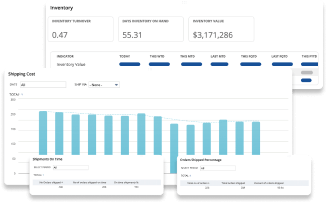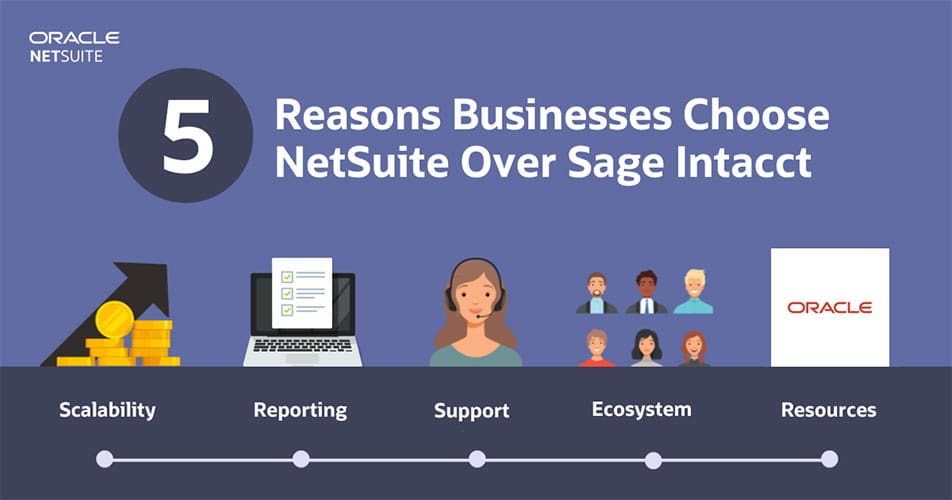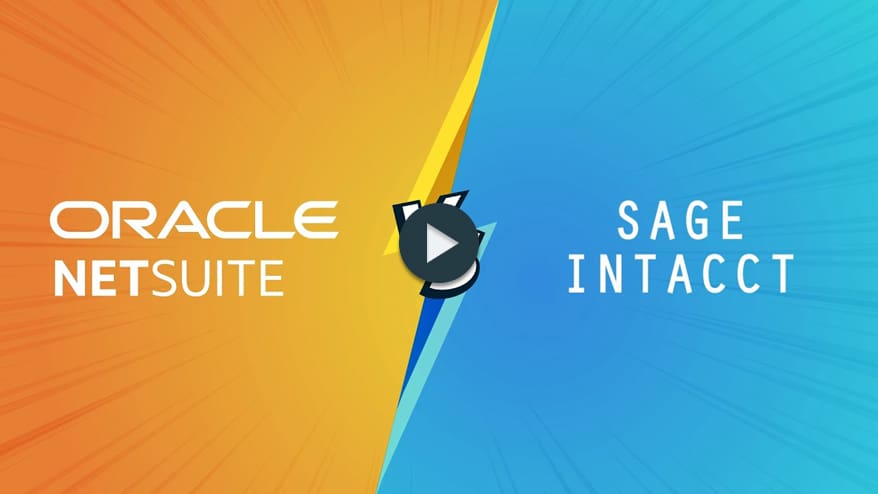Startups are joining companies outgrowing entry-level accounting systems such as QuickBooks and those saddled with older, on-premises enterprise resource planning (ERP) software and turning to cloud ERP systems to run their core business processes.
Oracle NetSuite and Sage Intacct were two of the first cloud ERP software providers and are often on the short lists of companies making ERP buying decisions. While both are true cloud ERP solutions with multitenant architectures and popular choices for growing and midmarket companies, there are some important differences that any business making an ERP purchase should consider.
Three major evaluation points where the solutions are substantially different are the ability to support an international business, manage multiple entities, and easily pull reports on any piece of the business. NetSuite also offers industry-specific editions of its software with the features, configurations, and reports and dashboards companies in those sectors need.
What Is ERP?
ERP is a suite of applications that automate a company’s core operations, including financials, inventory and order management, customer service, procurement, sales, marketing, and more. Because all modules operate from a single database, a modern ERP system delivers automation, collaborative workflows across departments, and sophisticated business reporting. More robust ERP systems also offer human resources management, professional services automation, ecommerce, and other capabilities.
Key Takeaways
- NetSuite and Sage Intacct are two popular software-as-a-service (SaaS) ERP systems with some similarities, but they have meaningful differences in functionality and system architecture.
- Intacct may have a lower upfront cost, but after a recent price increase Intacct’s cost per full-access user license is now more than twice that of NetSuite. In addition, Intacct charges extra for subsidiaries, consolidations, reporting, customization, and APIs that can quickly drive up the total cost of ownership.
- NetSuite has stronger native capabilities for financial consolidations, reporting, CRM, and professional services automation (PSA) than Intacct, and the vendor lacks a solution comparable to OneWorld for multinational and multisubsidiary businesses.
- NetSuite’s SuiteSuccess implementation methodology that helps customers go live faster at a predetermined price is a key differentiator, as are the platform’s numerous tools to customize and integrate the software with other applications.
NetSuite vs. Sage Intacct: An Overview
Both NetSuite and Intacct are cloud-based ERP systems with multitenant, SaaS deployment models. In a cloud ERP deployment, the software vendor maintains the software and database in its own data center. Customers access the software via the internet and typically pay a subscription fee.
With multitenant cloud suites, all customers are on the same version of the software thanks to automatic upgrades, which makes updates easier and creates economies of scale. Customer data is separated at the database level for privacy.
While there is some overlap between NetSuite and Intacct, their differences can best be summed up by the fact that NetSuite was designed to run an entire business, while Intacct was built to handle only accounting and finance. NetSuite offers significantly more breadth, including modules for robust customer relationship management (CRM), ecommerce, field service management and human capital management (HCM) that Intacct lacks.
Intacct fills in some of these gaps with add-on applications, but the product doesn’t offer the same level of functionality as NetSuite’s modules. For example, Intacct’s subledger architecture inherently limits reporting, and its limited multilanguage support and difficulty with currency conversions pose challenges for those that conduct business internationally.
Additionally, NetSuite has a larger partner ecosystem and advantages when it comes to implementation services that ERP buyers may want to consider.
NetSuite has a greater breadth of functionality with modules for additional functions, so businesses can start with a core financial package and add features as they grow. This has helped NetSuite become the industry leader among fast-growing businesses, especially among SaaS and other technology companies.

How 4 Companies Dropped Intacct for NetSuite
See how these four businesses transformed billing, international expansion, and integrations—all by switching to NetSuite. Dive into the details to find out if that’s the best move for your business.
Read NowProduct Maturity and History
NetSuite was cofounded in 1998 by Evan Goldberg, an entrepreneur and early Oracle employee, and Oracle founder Larry Ellison. Goldberg approached Ellison with an idea for a new venture after struggling to find a single system on which to run a previous business he had started. The resulting company, NetSuite, was a pioneer of the SaaS model and went public in 2007.
Intacct was founded in 1999 as a suite of accounting applications for small and midsize businesses by David Chandler Thomas, an economist and professor at Ball State University, and Odysseas Tsatalos, a technologist. It received several rounds of venture funding but never filed for an IPO.
While the software products are close in age, NetSuite boasts a much larger customer base and an expansive global footprint. It has more than customers in 219 countries and territories. Intacct has about 24,000 customers, mostly in North America. It also has operations in Australia, South Africa, and the United Kingdom, but limited support for businesses with non-English speakers.
Video: NetSuite vs. Intacct
Acquisitions by Sage and Oracle
NetSuite was acquired by Oracle in 2016 for $9.3 billion and is now run as a separate business unit within the company. Oracle’s backing enabled NetSuite to more quickly expand its international operations and open new data centers based on the powerful Oracle Cloud Infrastructure (OCI)(opens in a new tab).
The Sage Group plc acquired Intacct in 2017 for $850 million. At the time, Sage operated a variety of on-premises accounting systems used primarily in the UK and had made little progress shifting to the cloud. The acquisition of Intacct gave it a bigger footprint in the United States and a viable cloud offering.
NetSuite vs. Sage Intacct: Vertical Industries
Below is a breakdown of core industries that NetSuite and Intacct serve.
| Industry | NetSuite | Intacct |
|---|---|---|
| Financial Services | ||
| SaaS Subscription and AI | ||
| Wholesale Distribution | ||
| Manufacturing | ||
| Retail and Ecommerce | ||
| Professional Services | ||
| Healthcare | ||
| Restaurants and Hospitality | ||
| Construction and Real Estate | ||
| Advertising, Media, and Publishing | ||
| Nonprofit | ||
| Transportation and Logistics |
NetSuite has an especially strong presence with SaaS companies, including some of today’s most recognizable and successful tech companies. These software businesses must account for revenue in a particular way and use industry-specific financial metrics to measure their performance, and NetSuite offers strong, proven functionality to satisfy these requirements.
NetSuite also offers editions for what it calls “microverticals” in areas including apparel, footwear, and accessories, food and beverage manufacturing, health and beauty, campus stores, education, professional sports, and more.
NetSuite vs. Sage Intacct
While there are obvious similarities in their cloud-based approach to financial software, there are some significant differences between NetSuite and Intacct that buyers need to consider before making a purchase. The most obvious is NetSuite’s suite-based approach to its platform, which includes modules for CRM, HR, ecommerce, supply chain management, and much more.
Although Intacct typically has a lower upfront cost than NetSuite, some businesses find themselves quickly outgrowing the software. While Intacct typically provides the functionality needed for those switching from an entry-level accounting system, as they expand, growing companies often confront limitations, such as a limited number of reports and complexity that makes building new reports difficult. The costs to add the capabilities these companies need, starting with more users, add up quickly, as shown below.
| Total Cost of Ownership with Intacct | |
|---|---|
| New users | Each new full-access Intacct user costs more than twice as much as the cost per user with NetSuite. |
| Subsidiaries | Intacct charges extra for each entity that uses the system, such as branch offices or country-specific operations. Consolidation of those entities for accounting and reporting purposes comes at an additional cost. Further complicating matters, Intacct has three different consolidation methods, each with different price points. In all, this can add as much as tens of thousands of dollars to your annual bill. |
| Customization | If an organization needs to create custom fields, reports—which still have limitations—or views, they must purchase Intacct’s customization service. This costs a few thousand dollars per year. |
| Interactive Custom Report Writer | Users have limited ability to customize or create custom Intacct reports unless they buy the interactive custom report writer. |
| Interactive Visual Explorer | The Intacct equivalent of NetSuite’s SuiteAnalytics reporting engine, the Interactive Visual Explorer, offers more ways to visualize data. However, unlike with SuiteAnalytics, users can only visualize certain linked datasets in the system. The Explorer adds another four figures to the yearly bill. |
| Platform Services | If a business wants to customize other elements such as workflows, email and XML templates, and custom menus, they need to subscribe to Intacct’s expanded platform services. Note that the platform services subscription eliminates the need for the customization service subscription. |
| Web Services | If companies want to handle integrations between Sage Intacct and other applications themselves, they must purchase a web services developer license for an additional cost per user. Since Intacct does not have a wide selection of modules like NetSuite, you’ll likely need to integrate your ERP with other systems, and the cost of those connections add up quickly. |
| APIs | Both vendors offer APIs to connect other applications to their platforms, but Intacct charges for API calls while NetSuite does not charge per call or for the total number of API calls made. NetSuite also offers more APIs that gives developers more options and flexibility to extend the application. |
| Sandbox | Intacct’s test environment only includes four free sandbox refreshes per year—after that, customers must pay professional services’ hourly rate. NetSuite, on the other hand, includes one complimentary sandbox refresh for each month the customer has the license. |
In all, extending and tailoring Sage Intacct to meet the needs of your business over time can add a substantial amount to the annual contract. With NetSuite, all of these capabilities are included in the licensing cost.
NetSuite offers the financial functionality that businesses moving off spreadsheets or entry-level accounting systems need while continuing to support them as they grow. As evidence of that, 61% of technology IPOs since 2011 are NetSuite customers, and 275 companies running on NetSuite have gone public via an IPO or SPAC since 2020. And that support extends to firms growing internationally—the system’s multilanguage, multicurrency, multisubsidiary, and international tax and regulatory compliance capabilities simplify global operations.
Additionally, NetSuite’s comprehensive, well-honed implementation methodology gets customers up and running quickly and lets them add functionality as they need it.
What happened with us on the Intacct side was that there weren't a lot of opportunities to have the application grow with us. NetSuite so far has been able to grow with us.
How NetSuite Compares to Sage Intacct
Financials
On the surface, both solutions can appear quite similar, as the table notes below. But the differences and benefits run much deeper. While there is overlap when it comes to the products’ financial management capabilities, Intacct’s licensing structure introduces cost and complexity, as the total cost of ownership table illustrates. To access features such as value-added tax (VAT) compliance and advanced reporting capabilities, for example, Intacct customers must purchase additional modules. As we’ve seen, all of this adds to the total cost of ownership and can hinder growth. Companies require more features as they grow and evolve, and with Intacct, each of those represents an added expense.
| Core Financials | NetSuite | Intacct |
|---|---|---|
| Accounts Payable | ||
| Accounts Receivable | ||
| AP Automation | ||
| General Ledger | ||
| Cash Management | ||
| Native Customizable Reporting | ||
| Fixed Assets Management | ||
| Subscription Billing | ||
| Revenue Recognition | ||
| Forecasting and Budgeting | ||
| Multicompany Consolidation | ||
| Multicurrency | ||
| Financial Planning and Analysis | ||
| Complex Multivariable FP&A | ||
| Global Accounting and Consolidation | ||
| Global Tax Management | ||
| Governance, Risk, and Compliance | ||
| Automated Account Reconciliation | ||
| SaaS Metrics |
= Native capabilities
= Some capabilities or requires partner
support
= No native capabilities
International management
For businesses with global operations, or those hoping to expand internationally, there are some important considerations when choosing between NetSuite and Intacct. NetSuite ERP includes multilevel consolidations out of the box. NetSuite OneWorld supports 27 languages, more than 190 currencies, transactions in 90-plus bank formats, and tax and reporting standards for more than 100 countries. That explains why NetSuite has customers in 200-plus countries and territories.
NetSuite OneWorld also offers multicurrency consolidations, allowing businesses to easily roll up data from subsidiary to parent level, and the system facilitates intercompany consolidation. That helps organizations establish consistent business processes. Additionally, your number of subsidiaries or need for customized reports does not impact NetSuite OneWorld pricing.
Intacct supports only three languages—English, French, and German— and as a result does not have a significant presence outside of English-speaking countries. Each business entity requires its own licenses and, because of Intacct’s subledger architecture, entities cannot access real-time data. Customers must subscribe to Intacct’s customization or platform services to run custom reports on subsidiaries.
Multisubsidiary consolidation is also difficult with Intacct, requiring a separate consolidation module and multiple consolidation methods to choose from with varying costs. Intercompany reports also require subscriptions to Intacct’s customization services, platform services, or custom report writer.
CRM
Intacct does not have a CRM offering. Instead, it relies on an integration with Salesforce.com. NetSuite has its own full CRM suite that includes sales force automation, customer service management, and marketing automation. And, because the CRM module is built on the NetSuite platform, it has real-time access to important data, such as billing and inventory. That gives sales, customer service, and marketing teams the information they need to do their jobs better.
NetSuite recently announced a direct connection to Salesforce.com CRM via a new NetSuite Connector for Salesforce, and businesses that use it will benefit from the fact that those CRM records sit inside of NetSuite. That means an organization’s vast CRM data elements are fully searchable and reportable within NetSuite, unlocking valuable insights and saving time.
Some businesses may not have a need for CRM today. But that could change, especially as they add more products or a services component. By choosing Sage Intacct, sales and marketing will not realize the benefits of a CRM that’s embedded in their ERP system.
| Customer Relationship Management | NetSuite | Intacct |
|---|---|---|
| Sales Force Automation | ||
| Customer Service | ||
| Marketing Automation | ||
| Sales Reporting and Analysis | ||
| Salesforce.com (SFDC) Integration |
= Native capabilities
= Some capabilities or requires partner
support
= No native capabilities
Human resources management system (HRMS/HCM)
NetSuite and Intacct also differ in their core human resources functionality.
NetSuite SuitePeople covers payroll, workforce management, and employee recognition and performance management. Together, these provide accurate and on-time payments to employees, staff scheduling and time tracking, clear employee goals, and timely performance reviews. The system’s comprehensive payroll functionality eases what can be a difficult process—without the right software, making sure employees are paid properly and promptly is complex and time-consuming.
NetSuite SuitePeople also provides the sophisticated analytics and reporting needed to manage a global HR organization.
Intacct offers some core HR functionality via its Sage People application. However, this is a separate software package, as is its payroll offering powered by ADP. Both require complex and expensive integrations.
The value of NetSuite’s unified data model again shows with HR software. Like with CRM, native support for HR means an organization can easily map data to NetSuite even if it doesn’t use SuitePeople for payroll or HR. This is not the case with Sage Intacct because the solution has never offered native HCM/payroll capabilities. This means Sage Intacct ERP and Sage People use separate data models that make it more difficult to see information on payroll and operational productivity side-by-side, for example.
| Human Capital Management | NetSuite | Intacct |
|---|---|---|
| Human Resource Management | ||
| Unified Platform for HR, Payroll, and ERP | ||
| Workforce Reporting and Analytics | ||
| Global HR |
= Native capabilities
= No native capabilities
Reporting and analytics
NetSuite and Intacct both offer business intelligence and analytics capabilities with reports and dashboards, including self-service reporting. But once again, there is a significant difference in the depth of the offering, along with data model limitations. Intacct offers 60 reports for core financials out of the box, while NetSuite offers more than twice as many reports.
Intacct offers a report writer that allows users to combine operational and financial data, but it carries an additional charge, and there are limits to its configurability and the data elements that may be included. This is due to Intacct’s architecture—it has separate data tables, each with information on a specific part of the business. Customers can access greater functionality with a range of bolt-on solutions, though these are often difficult to use and bring added expense.
In online reviews, businesses evaluating cloud ERP systems have reported that Intacct’s dashboards are more difficult to use than expected based on the demos they were shown. This is because screens and dashboards shown during the demonstration are suggestions for the finished product rather than a standard part of the software package. The solution you get depends largely on the competence and experience of your implementation team, adding uncertainty.
There are no concerns about data tables with NetSuite because it stores and shares all data in the same database. This makes it much easier for staff to get the data they need from the system. NetSuite provides self-service reporting through what it calls “Saved Searches,” and its global search bar and reminders portlet can access any information across the system—finance, supply chain, CRM, HR, and more.
NetSuite SuiteAnalytics provides dashboards and reports sorted by role and industry are populated with real-time data from the platform and easy for your staff to adjust to their preferences. For example, NetSuite has metrics and dashboards designed specifically for SaaS companies based on what’s most important to them. Customers can build on these capabilities with NetSuite Analytics Warehouse, which lets them consolidate NetSuite data with that from other systems for even deeper insights and visualization.
Finally, Excel spreadsheet exports from NetSuite maintain formats and formulas so various employees can conduct ad-hoc analysis as needed. There’s no simple way to do that with Intacct.
Professional services automation
Both NetSuite and Intacct deliver functionality for services businesses, but NetSuite’s offering is more robust. With SuiteProjects, it provides a full PSA application with billing, project management for collaboration and status updates, resource management to ensure the right people are on the right job at the right time, project accounting to connect projects directly to the finance system, timesheet management, and expense management. NetSuite's PSA capabilities are proven, mature, and stable—tens of thousands of our customers are project-driven organizations. SuiteProjects also includes Project 360, which gives project managers a single dashboard to track critical KPIs and project performance through visualizations. This helps them make decisions that boost bottom-line results and mitigate risk.
Conversely, Intacct has a storied history of partnering with a multitude of PSA point providers to mask gaps in their platform. Their most recent effort is currently known as “Sage Intacct PSA.” This new solution is powered by a partner called Forecast. Forecast is a startup that closed its most recent funding round (Series A) in 2021 and bills itself as an “AI-powered application” but lacks the proven track record or sizable customer base of NetSuite’s PSA solution.
Aside from that, Intacct offers some Gantt charts and a projects module that provides billing along with some resource, expense, and timesheet management features.
| Professional Services Automation | NetSuite | Intacct |
|---|---|---|
| Timesheet Management | ||
| Billing | ||
| Project Management | ||
| Project Accounting | ||
| Resource Management |
= Native capabilities
Production and supply chain
For businesses that manufacture, sell, or distribute physical goods, production and supply chain capabilities are another key consideration when selecting an ERP system. While Intacct is just now launching into this space, NetSuite has provided the functionality products companies need for decades. And as you can see in the comparison table below, NetSuite has much more complete and extensive supply chain and production capabilities.
| Production Management | NetSuite | Intacct |
|---|---|---|
| Product Data Management | ||
| Work Order Management | ||
| Demand/Supply Planning and Forecasting | ||
| Quality Management | ||
| Manufacturing Execution System (barcoding, HMI) | ||
| WIP and Routing | ||
| Configure, Price, Quote (CPQ) |
| Supply Chain and Warehouse Management | NetSuite | Intacct |
|---|---|---|
| Order Management | ||
| Inventory Management | ||
| Procurement | ||
| Global Supply Chain Planning and Execution | ||
| Warehouse and Fulfillment | ||
| Warehouse Management System (WMS) | ||
| Demand Planning |
= Native capabilities
= Some capabilities or requires partner
support
= No native capabilities
Field service management (FSM)
For companies that generate some or all of their revenue from field services, NetSuite Field Service Management can help increase efficiency and lower costs. The software shows the current status and location of technicians and a scheduling board to reduce back-and-forth communication with the office and help technicians complete more jobs. NetSuite Field Service Management also has a mobile app that will alert field workers to new jobs and gives them all the information they need about that job, including customer and asset history. Critically, NetSuite Field Service Management is a native solution built on the NetSuite platform, which means it can utilize powerful NetSuite workflows to bring the full power of NetSuite’s multidimensional reporting to your field services.
Sage Intacct does not have a native field service management solution. It often turns to a myriad of point solutions, many of which might have similar capabilities as NetSuite’s field service software, but these still require an integration. The vendor does have a solution under the Sage umbrella called Sage Field Operations, but once again this system is not native to the Sage Intacct platform. It also does not have drag-and-drop scheduling or a mobile app. On top of these issues, it is not available to all customers—businesses must be running Sage 100 Contractor, Sage 300 CRE, or Sage Intacct Construction to use Sage Field Operations.
Omnichannel commerce
When it comes to omnichannel sales, NetSuite offers more functionality than Intacct through its SuiteCommerce modules. Here are how the two solutions compare in key functional areas:
| Omnichannel Commerce | NetSuite | Intacct |
|---|---|---|
| Real-time Omnichannel Tracking | ||
| Native B2B Functionality | ||
| Embedded Promotions Tool | ||
| Content Management Tools |
= Native capabilities
= Some capabilities or requires partner
support
= No native capabilities
Mobile support
NetSuite and Sage Intacct are both cloud applications accessed through an internet browser, meaning teams can access their data from anywhere with an internet connection. One key distinction is that Intacct does not have a mobile app, while those on tablets and smartphones can take advantage of NetSuite’s free mobile app for a better experience.
Intacct encourages users to access the system through mobile browsers, but consider the advantages of a dedicated app:
- Better user experience and adoption. Many employees prefer mobile apps over mobile websites, as suggested by the fact that they spend 88% of their time(opens in new tab) on mobile apps and just 12% of their time on mobile websites.
- Enhanced safety and security. Native apps must meet security standards to earn approval from the major app stores where users download them.
- Greater efficiency. A well-designed mobile app is generally much faster than a mobile site. Apps usually store their data locally on mobile devices instead of the web servers that websites use, meaning data retrieval is faster in apps.
- Ability to work offline. Apps might require internet connectivity to perform most tasks, but they can still offer basic functionality to users in offline mode. Mobile sites may be able to use caching to load web pages without a connection, but it’s unpredictable and limited.
Implementation Considerations
Intacct and NetSuite are both cloud-based systems, which negates the need to install and maintain hardware and data centers, as required by on-premises ERP systems. However, there are still many challenges in an ERP implementation that can disrupt a business’s operations. That makes finding a trusted partner well-versed in proven ERP implementation best practices a vital factor in an ERP selection.
NetSuite customers often work with NetSuite Professional Services, a large division with many employees in the US and elsewhere across the globe, or a NetSuite partner to complete their projects successfully. NetSuite has also pioneered an ERP implementation and customer engagement process it calls SuiteSuccess. The SuiteSuccess methodology is based on data gathered over NetSuite’s 25-plus years of successful ERP implementations and includes industry-specific best practices, templates, rapid implementation methodologies, and custom code. It provides dashboards and KPIs that are customized by role and industry.
| Customer Experience | NetSuite | Intacct |
|---|---|---|
| Implementation Type | In-house emphasis | Partner emphasis |
| Implementation Price Model | Fixed bid | Time & expense |
| Depth of Integration Experience | ||
| Customer Engagement Methodology | ||
| Dedicated Account Management | ||
| Preconfigured Instance | ||
| Cloud Customer Community |
= Native capabilities
= Some capabilities or requires partner
support
= No native capabilities
As a result, SuiteSuccess customers can get their ERP systems up and running in as few as 100 days. And, SuiteSuccess includes post-implementation support to help businesses expand beyond core financials into areas such as CRM, PSA, HR, and ecommerce when they’re ready to do so.
Intacct has a small in-house professional services team largely based in North America but relies on partners to handle many implementations. Know that these partners may turn to offshore teams to help with your implementation. The software provider also has nothing analogous to SuiteSuccess. The quality of the finished product depends largely on the knowledge and expertise of the implementation partner.
Database and Architecture Considerations
NetSuite runs on the Oracle Database. And, since its acquisition by Oracle, NetSuite has migrated all of its customers to instances hosted in OCI data centers spread around the globe. Additionally, as NetSuite transitions to Oracle’s Gen 2 Cloud Infrastructure, customers will enjoy even greater security, availability, scalability, and expandability, plus a path to the advanced Oracle Autonomous Database(opens in a new tab) and artificial intelligence.
Intacct also runs on the Oracle Database in two data centers based in Sacramento and San Jose, California, that are run by Quality Technical Services and Equinix, respectively. Both are third-party data center service providers. It also operates a data center in Dublin for UK customers and Montreal, Canada, via Amazon Web Services (AWS) Canada.
Platform and Integration
Both vendors offer developer platforms based on industry-standard JavaScript for customers and partners who wish to develop their own customizations, functionality, and applications. Both also provide integrated development environments (IDEs) and APIs to connect other applications to their platforms. However, Sage Intacct charges for API calls, while NetSuite does not charge per call or for the total number of API calls made.
NetSuite offers integration and platform tools including out-of-the-box REST- and SOAP-based web services APIs to connect the ERP system with other applications; a JavaScript API to create custom REST endpoints; a no-code workflow designer called SuiteFlow; VS Code and WebStorm IDEs that make it easier for developers to write code in NetSuite; and a SQL connector to export data from the system.
NetSuite’s platform API options give developers and partners flexibility so they can build powerful business applications called SuiteApps that enhance the ERP solution’s capabilities.
NetSuite’s integration API options give integrators and developers flexibility since it comes with standard support for JSON/XML data formats and options to define custom integration formats. Developers can define powerful server-side business logic and expose it for external RESTful consumption to extend out-of-the-box APIs to support additional automation and complex integrations.
NetSuite also empowers developers to query and analyze data by issuing SQL statements via REST API with SuiteQL. This enables RESTful access to NetSuite datasets created with SuiteAnalytics tools.
The Sage Intacct accounting platform also offers customization and integrations through open, XML-based APIs and software development kits (SDKs). But it cannot match NetSuite’s robust customization options and Intacct customers must pay for access to REST APIs.
For both NetSuite and Intacct, customizations automatically carry forward with each upgrade.
| Platform | NetSuite | Intacct |
|---|---|---|
| True cloud | ||
| Partner app store | ||
| Mobile | ||
| Seamless upgrades | ||
| Ease of customization | ||
| All customers on latest version | ||
| Single data model | ||
| Customizable workflow automation (beyond approvals) |
= Native capabilities
= Some capabilities or requires partner
support
= No native capabilities
Partner Ecosystems
NetSuite’s partner ecosystem also offers programs for value-added resellers, solution providers, and an accountant-specific program, along with an Alliance Program for global system integrators and a business process outsourcing (BPO) partner program for companies that offer accounting, customer support, and ecommerce services.
Its SuiteApp.com(opens in a new tab) marketplace features more than 700 add-on apps that are either built on the NetSuite platform or tightly integrated with it.
NetSuite Pricing vs. Sage Intacct Pricing
Both Intacct and NetSuite base their pricing on the per-user/per-month model that is typical in the SaaS industry. Both vendors offer more functions for additional monthly fees, and both require one-year contracts renewed annually, at a minimum.
Intacct charges extra for each entity that uses the system, such as branch offices or country-specific operations. Companies with more than a handful of subsidiaries pay a flat fee rather than for each one separately. Either way, that can quickly get expensive for growing businesses or franchisers. The price of NetSuite OneWorld, however, does not change based on the number of subsidiaries.

Discover how NetSuite is the right system for your business, and make a switch.
Schedule a ConsultationSupport Services
NetSuite does not outsource support—it employs more than 1,000 people in support roles—and has live customer support available 24 hours a day, seven days a week. It also assigns a dedicated account manager to each customer. This applies regardless of whether you used NetSuite Professional Services or a partner to implement your system. The company offers three levels of support—Basic, Premium, and Advanced—supplemented with a self-serve knowledge base called SuiteAnswers and a user community to help answer questions.
Intacct also has live agents available 24/7 and multiple levels of support. The company has a user community, as well, that may help answer questions. However, it's important to note that support resources are ultimately determined by who handled your implementation—if a partner did, Sage Intacct direct assistance is not readily available. Also, businesses that use Intacct must log into an entirely separate system to view and manage their support tickets.
What Are the Functional Differences Between NetSuite and Sage Intacct?

Businesses choose NetSuite over competitors due to its ability to grow with their businesses and more comprehensive reporting and support.
Let’s look at three specific areas.
Subledger architecture
Unlike Intacct, NetSuite’s unified database does not rely on subledgers or batch processing. NetSuite saves all transactions in real time and transfers full details to the general ledger for more complete data.
Subledgers are a series of transactions grouped by type, such as sales accounts or fixed asset accounts. Systems like Intacct rely on subledgers. Intacct transfers items from journal to ledger to financial statement in a linear order—because the system cannot unify all the data in a single database, that linear process is the only way to keep inaccuracies from entering the general ledger. Batches are then posted to the books.
Even though Intacct claims “real-time batch processing” or “continuous batching,” a significant portion of its help documentation is dedicated to helping customers navigate batch discrepancies, subledger reconciliation implications, and subledger cautions/considerations. This problem never has nor will exist with NetSuite.
Subsidiary management
Intacct’s subledger architecture also makes multisubsidiary consolidation difficult and dependent on an additional consolidation module, as noted earlier. In contrast, NetSuite users have easy access to detailed subsidiary data through its Subsidiary Navigator tool. They can also click through consolidated reports for a more detailed view of any one entity.
The consolidations process in Intacct does not allow companies to drill drown to source transactions from the consolidated trial balance when dealing in multiple currencies. Customers find themselves spending considerable time on workarounds to calculate a fully auditable trial balance.
Intacct’s subsidiary management mimics intercompany accounting by using customer books and custom journal entry methods without posting real entries into entity-level books. This makes the process fast and easy in some ways, but you lose traceability of the consolidations process.
NetSuite also provides out-of-the-box tools to make intercompany accounting easier. The system’s multientity capabilities automate matching and elimination of intercompany transactions to simplify the intercompany netting process. It makes numerous intercompany accounting reports available out of the box.
In contrast, Intacct does not provide intercompany reports out of the box. Instead, Intacct delivers interentity reporting as a customized reporting package, thus users must subscribe to customization services or platform services to access it. Even then, accessing reports for varied business units or countries requires navigating multiple dropdowns and browser tabs.
Workflows
Both Intacct and NetSuite offer configurable workflows, but Intacct’s are more constrained and support only basic processes. This may create a lack of visibility that could grow into a compliance issue.
NetSuite SuiteFlow lets employees automate business processes without writing any code through a drag-and-drop, What You See Is What You Get (WYSIWYG) interface. SuiteFlow is a powerful tool that works across modules and lets companies automate complex processes based on configurable business rules.
Intacct also has a tool to create automations, but it is not as visual or simple as SuiteFlow and has limited applications. With Intacct, you can only set up basic approval processes for items such as journal entries and purchase orders.

Find the Right ERP for You
Discover nine questions you should ask software vendors and the specific system capabilities you need in this one-page guide.
Download Guide (opens in new tab)NetSuite Is a System for Growth
While Intacct often offers a lower upfront cost, NetSuite is typically the financial software of choice for growing companies, particularly those that require the more advanced functionality and scalability that NetSuite delivers and may be targeting funding rounds—NetSuite customers have raised $245 billion in venture funding since 2020—or IPOs. Companies running on NetSuite with international operations or aspirations also tend to select NetSuite OneWorld thanks to its multilanguage, multicurrency, and multisubsidiary management capabilities.
NetSuite vs. Intacct FAQs
Is NetSuite easier to use than Sage Intacct?
Both NetSuite and Sage Intacct have intuitive user interfaces accessible through web browsers. However, some customers have reported it’s difficult to tailor dashboards to their needs in Intacct, which is a straightforward process in NetSuite. It can also be challenging to drill down to the source data in certain Intacct reports compared to NetSuite.
Are NetSuite and Sage Intacct cloud-based solutions?
Yes, both NetSuite and Sage Intacct are cloud systems provided via a SaaS model. This means the vendor manages all infrastructure, upgrades, and other updates, so all customers are always on the same version of the software.
Does NetSuite offer more advanced reporting and analytics capabilities than Intacct?
NetSuite comes standard with more reporting capabilities and out-of-the-box financial reports than Intacct. The architecture of Intacct can lead to certain limitations with reporting and require add-ons that aren’t necessary with NetSuite because all information is in one shared database.
Does NetSuite offer better customer support and training than Intacct?
Both software vendors offer multiple levels of support and have agents available 24/7, but Intacct direct assistance is limited if a partner implemented the solution. NetSuite also offers NetSuite Learning Cloud Support (LCS), which provides extensive training options with on-demand access to role-based curriculums and live trainings.
How customizable are NetSuite and Intacct to meet specific business needs?
NetSuite and Intacct are both designed to be configured and customized to meet the unique needs of your business. The two systems have tools that let business users build workflows, but NetSuite SuiteFlow is more powerful than Intacct’s offering.
Which software is better for ecommerce businesses, NetSuite or Intacct?
Ecommerce is one of the core industries NetSuite serves and there are many well-known online retailers that use NetSuite. It has a strong and longstanding foothold with products companies thanks to deep functionality in the areas they need. NetSuite also has SuiteCommerce, a native ecommerce solution for B2B and B2C sites, which Intacct lacks. Both providers have solutions to integrate their ERP systems with popular ecommerce software including Shopify and Magento.
Does NetSuite or Intacct offer better multicurrency support?
Intacct has some issues with currency conversions and only supports English, French, and German, so most of its customers are in North America. NetSuite OneWorld has multicurrency and language support, which is why customers in more than 200 countries and territories use the software.





